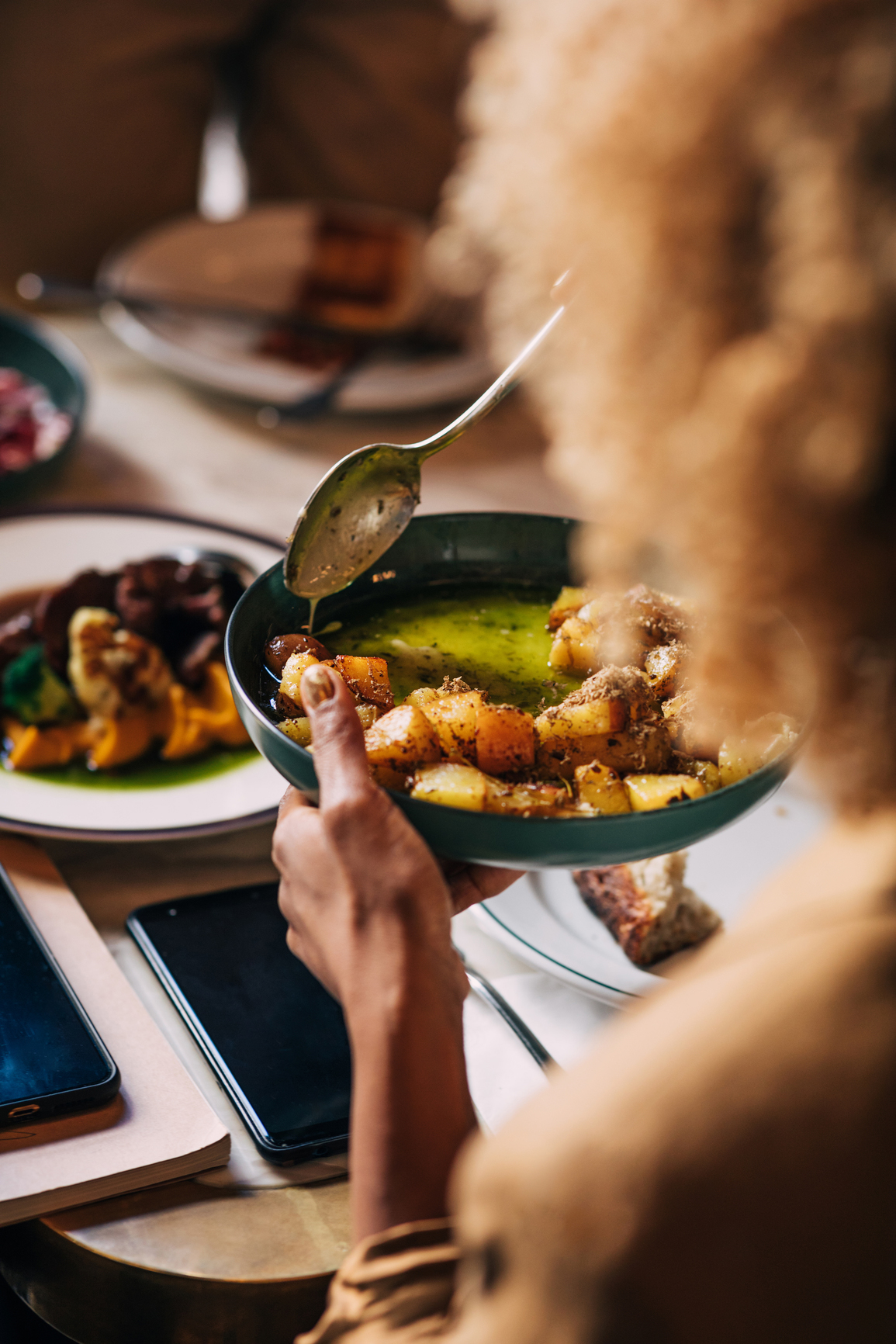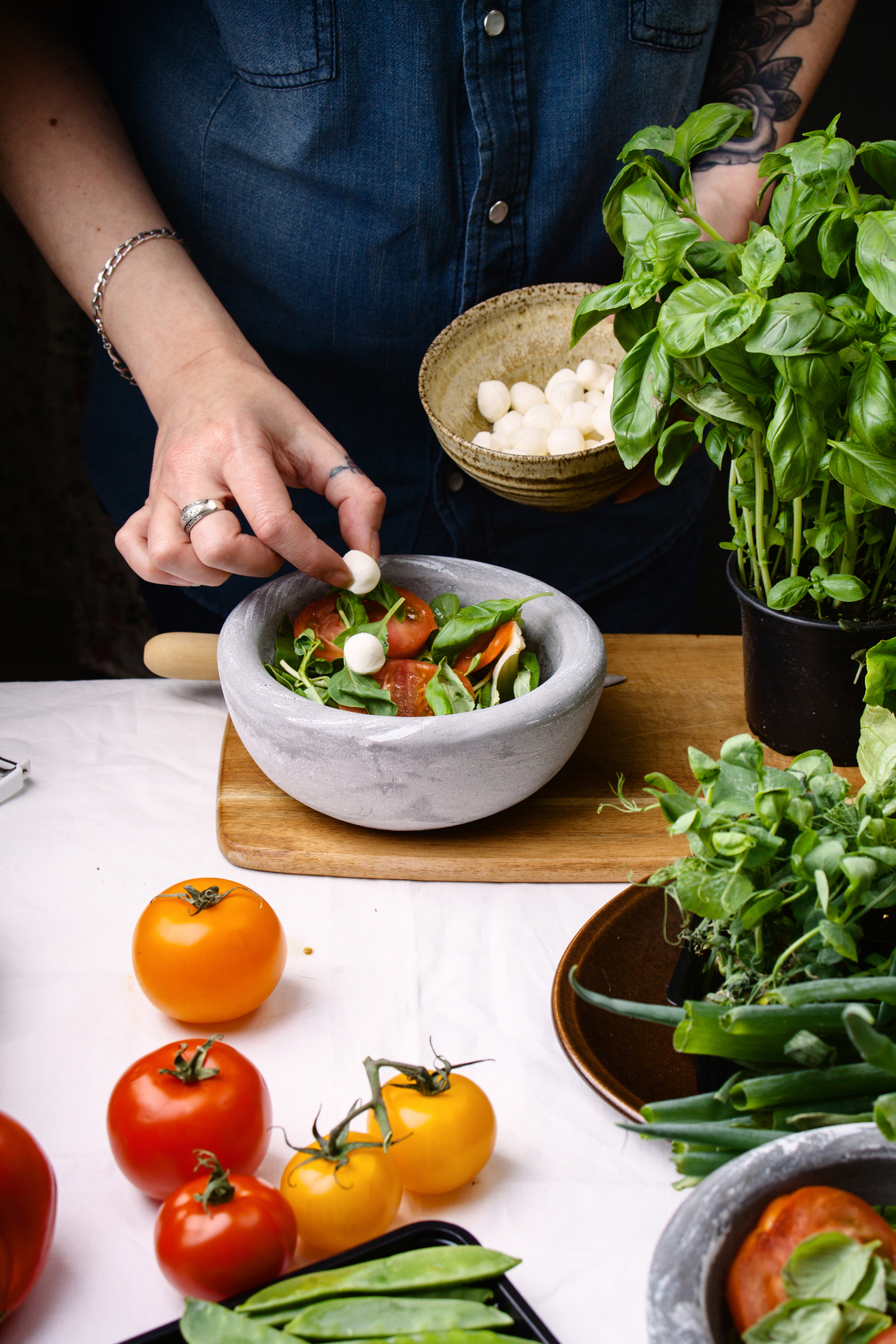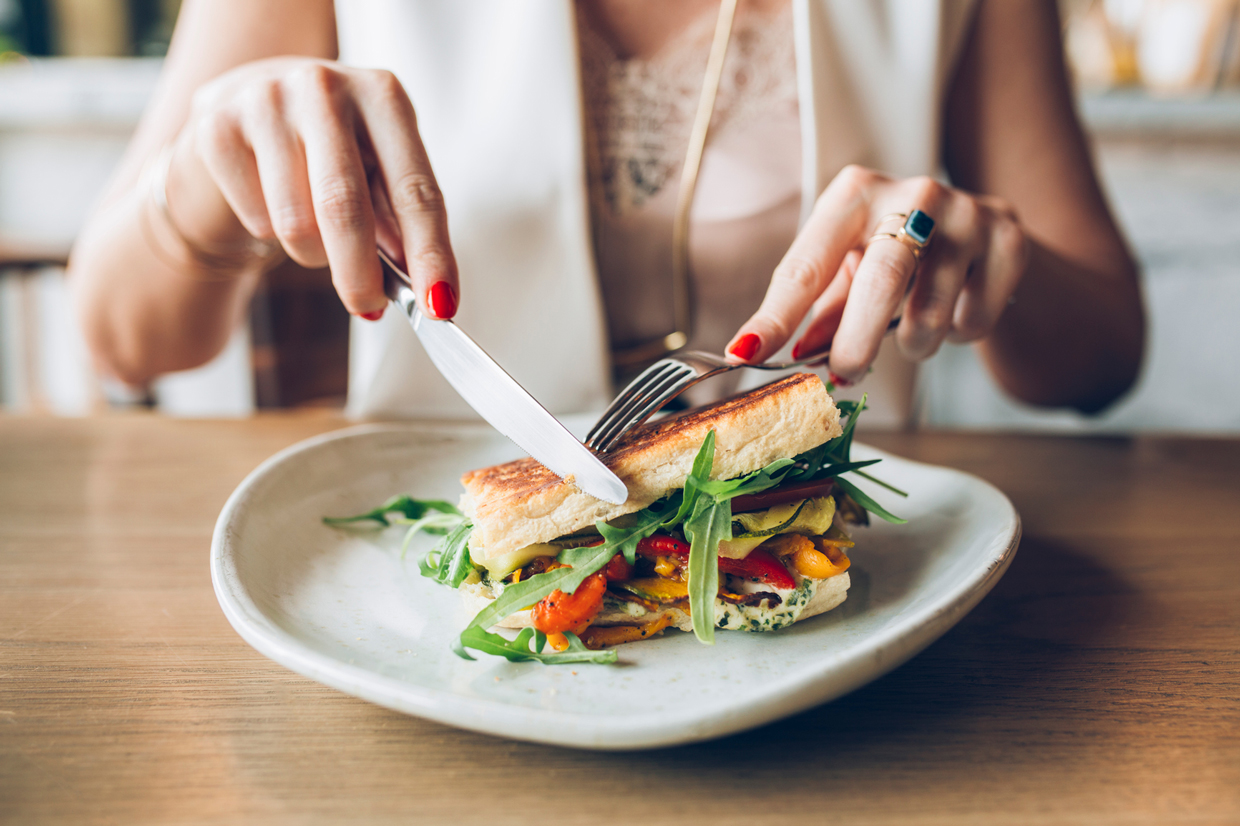Mealtimes for me — particularly during the pandemic age — typically go like this: In the morning, I shove down an Eggo waffle (read: quick carbs) while I’m hovering over the kitchen island preparing my daughter’s breakfast/lunch/snacks for the day. Then a few hours later, my lunch teeters on a stack of magazines next to my laptop as I take bites in between shuffling through work emails and working. When my husband and I finally sit down for dinner, we eat in front of the TV and by the time we queue up something remotely interesting on Netflix, we’ve usually scarfed down all our food by the time the opening credits are finished. We often joke about how we’re in a nightly eating competition on who can finish their plate faster.
I always considered my typical eating habits as multitasking, but it turns out that these habits are classic cases of mindless eating. “Any time that you’re doing something else while you’re eating is naturally going to make you less mindful about what you’re eating,” says Lynn Rossy, Ph.D., a health psychologist, author of The Mindfulness-Based Eating Solution and president of The Center for Mindful Eating. Mindful eating, on the other hand, is about paying attention to what you eat and focusing on the experience of the food and how your senses engage with it.

For most of my adulthood, I’ve chased after different ways to improve my IBS issues, from FODMAPs to experimenting with fascia foods to trying out food sensitivity tests — all of which required a pretty drastic change to my diet that I personally wasn’t able to keep up with for the long run. But when I learned about mindful eating, I was intrigued with how I could still keep eating everything I already love to eat and not drive myself crazy about ingredients or do anything restrictive. I dived in with Rossy on the benefits, how to practice it, and how it played out for me IRL.
The Benefits of Mindful Eating
Mindful eating is a way to slooooow down during meals and learn how to savor food. If you’re constantly trying to multitask while you’re eating — whether that’s munching while watching TV, grazing while you’re working, or even sneaking in bites of takeout while you’re driving — you’re a good candidate to try out mindful eating. “My favorite reason to mindfully eat is because food is a pleasurable experience that you can have multiple times a day,” says Rossy.
Other benefits of the practice include: learning how to eat when you’re actually hungry (as opposed to responding to emotions or stress), knowing when to stop eating when you’re full, and making healthier choices when you eat. It also extends to psychological advantages: “It’s not a diet, and it’s not about losing weight. It’s about changing your relationship with food in your body,” says Rossy. Since mindful eating doesn’t require you to change or restrict the food you eat, it relieves you from the stress of thinking and planning about food all the time. It doesn’t mean you can eat unlimited amounts of everything you see in sight, but if you want that piece of oreo cookie cake, you can have that oreo cookie cake without the guilt that a lot of diet plans leave you with.
How to Get Started
No matter if you’re having a kale salad or a fried chicken sandwich, mindful eating is practiced the same way. Though there are many different approaches to mindful eating, BASICS is an acronym that Rossy uses to, well, help you learn the basic guidelines. The point is that you don’t need to be perfect, but it’s all about bringing more awareness to what you eat. “I don’t think it’s realistic to think that people are never going to multitask while they eat — I think that’s prohibitive,” says Rossy. “People that practice mindfulness are able to take their attention back and forth from eating, tasting, feeling, sensing, to whatever else they’re doing somewhat effectively. However, when you’re first learning how to practice mindful eating, I think it’s important to have times where you just focus on eating. I tell students to practice it at least every day for 10 weeks to gain the skills they’ll need,” she says.

B: “B stands for taking a breath and doing a belly check,” says Rossy. Not only does breathing relieve stress that often leads to rushed eating and unhealthy choices, “breathing engages the rest-and-digest response. So before you reach for food, start to take a few deep breaths. Many of us are stressed and taking a few deep breaths helps us to move into parasympathetic nervous system activity, which prepares the body to receive food,” she says. Then, check in with your stomach: “Are you actually, physically hungry? Or, is it because you’re bored or just in the habit of eating at a certain time? You’ll begin to learn patterns about when and why you reach for food,” she says.
A: “A is about assessing your meal,” she says. “If you decide that you are really hungry, then you decide what it is that you want to eat. What food did you choose? Does it look good? What color is it? What does it smell like? Do you know where it came from? Just take a moment to consider what it is that you’re putting in your body and if it’s something that you’re really going to want.”
S: “S stands for slowing down,” says Rossy. “It helps you enjoy your food to the fullest. “Most of us eat way too fast. You can slow down by making sure you put your utensils down in between bites so that you can be with each bite instead of shoveling one bite of food after the other. You want to eat one bite and finish it before you go on to the next. No need to make it miserable, but take your time.”
I: “I is about investigating your hunger levels, specifically when you’re at the halfway point of your meal. This is how we start learning how to stop eating based on physical satiety cues. So, is your stomach feeling full? Have you been satiated with a pleasant taste? For instance, if you’re eating a small piece of chocolate, you might not feel physically full from it, but your tastebuds might be satisfied. You want to check in with both the mouth and the belly to see a combination of ‘enoughness.’ Now beware of the mind, which always wants more,” she says. Don’t feel pressured to “clean your plate.” Give yourself some space to assess your hunger throughout your meal.
C: “C stands for chewing thoroughly,” she says. Not only does this aid in slowing down, “it helps get you more nutritional value out of the food. When you chew it in your mouth, you’re taking in the nutrition there as opposed to in your stomach. When the body feels nutritionally fed, it will tell you it’s not hungry anymore. Your body really wants to feel like it’s been fed nutritionally, so that’s why we also need to think about what we are putting in our body so that it can feel that way, because it operates better when we do that. Even if we’re eating processed foods or foods that aren’t as nutritionally dense, when we chew thoroughly we’re still getting the most out of the food that we can get, which is going to be helpful,” she says.
S: “S is about savoring your food,” she says. “We have the wonderful opportunity to bring pleasure to our lives multiple times a day by savoring food. It could be as simple as enjoying the experience of peeling a fresh orange, smelling its scent, and noticing how your mouth waters. Savoring your food encourages you to be fully present in your meal.”
Make Mindful Eating Work For You

When applying mindful eating to my everyday life, I knew it wasn’t realistic for me to practice this for all of my meals right off the bat. “You’re going to see that you’re not going to be able to do it at every single meal, and that’s okay,” says Rossy. “But set the intention to do it at least once a day,” she says. Once a day felt feasible for me, and I found that I was able to be more consistent with lunchtime when I had less distractions while my daughter was at school. Especially in the beginning, it was helpful that you can take whatever parts of mindful eating practices that work for your lifestyle. On days I’m super pressed for time and feel overwhelmed with following the whole BASICS acronym, I’ll focus on just chewing thoroughly, or I’ll concentrate on assessing my food. I found over a few weeks of mindful eating, I reached for snacks less often, and I was more in tune with differentiating hunger from simply needing a glass of water. While I can’t say my IBS has completely disappeared, I noticed its severity decreased on days that I committed to mindful eating. My biggest takeaway is that I learned to appreciate the food that I get to eat on a daily basis — especially around the holidays when overindulging is the norm. Food is more than fuel, but it can be a beautiful part of how you enjoy life.
We only recommend products we have independently researched, tested, and loved. If you purchase a product found through our links, Sunday Edit may earn an affiliate commission.







